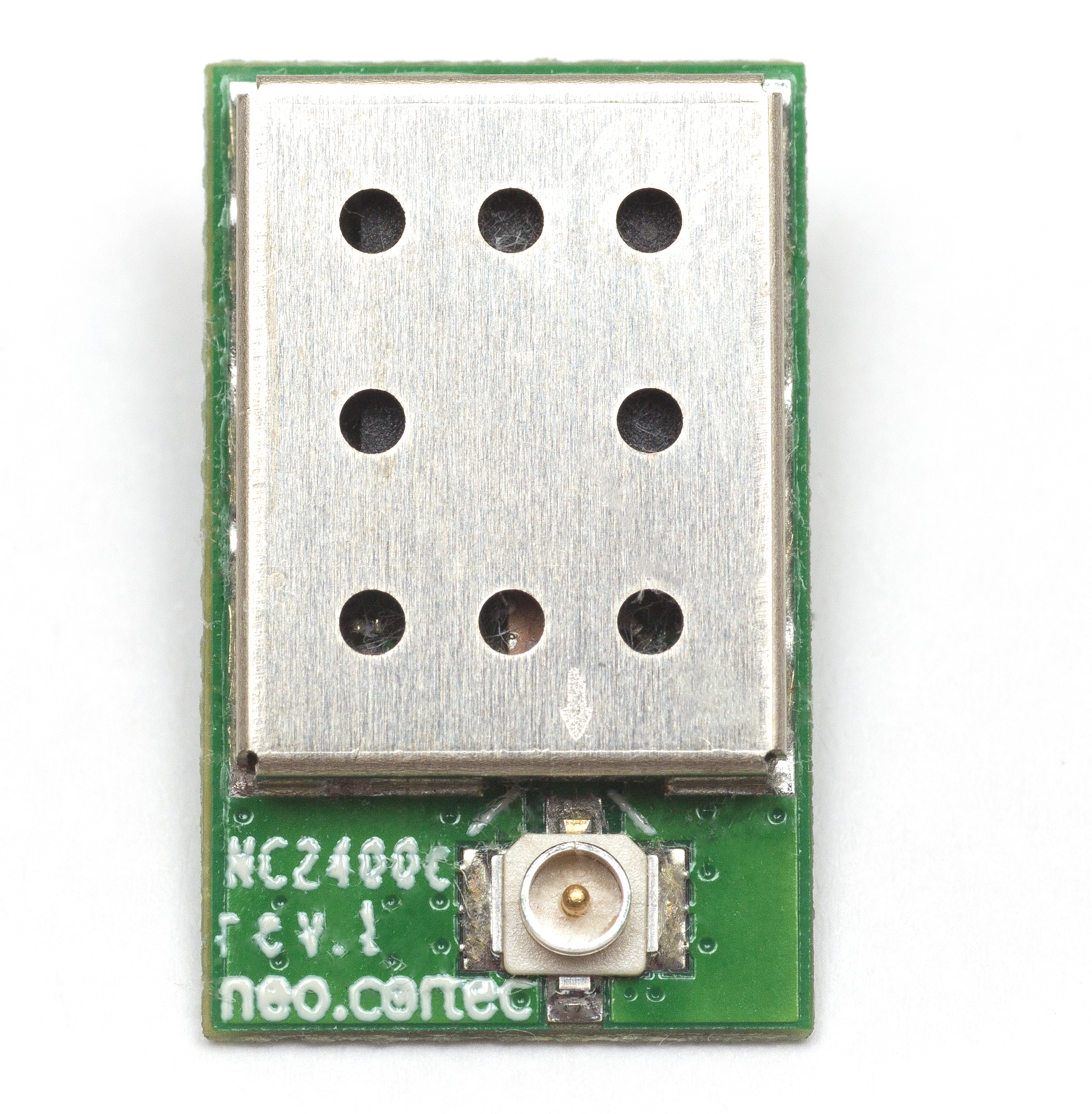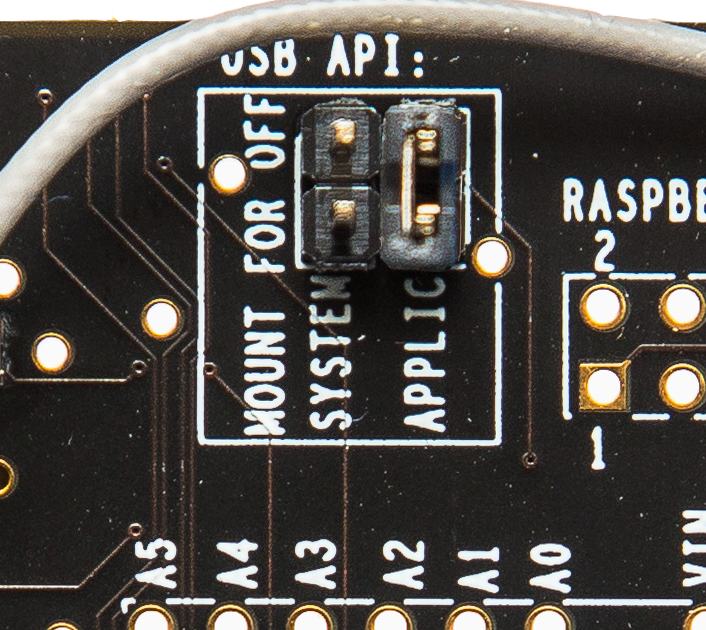Hardware
Description
The NeoCortec development board offers you an opportunity to explore the possibilities with NeoMesh right out of the box. Your devices come with a factory configuration, enabling them to function without additional configuration.

Demo Board
Before moving on to the tutorials, explaining the use and capabilities of the NeoMesh network, familiarizing ourselves with the configuration of the demo board is necessary.

NCxxxx module:
The evaluation board is built around the NEOCORTEC NCxxxx. The module utilizes the NeoMesh technology to create a reliable, adaptive network with other devices in its vicinity. The module is available in several frequency bands. The currently available modules are:
 |
 |
 |
|---|---|---|
| NC1000-8 | NC1000-9 | NC2400 |
| 868MHz SRD | 915MHz ISM | 2.4 GHz ISM |
SMA-RF connector
The SMA-RF connector offers an opportunity to attach your own an antenna to your evaluation board. By default, a helix antenna comes packaged in your evaluation kit for every board, but should the need arise, to test the evaluation board with your unique aerial, disconnect the RF jumper wire from the SMA-RF connector and attach your own antenna to the NeoCortec NCxxxx module.
USB port
The evaluation board can be connected to your computer through a Micro USB port. Through this single physical interface, the Evaluation board provides two serial communications ports, which are used for each their own individual purpose:
| Application API | For sending and receiving payload data through the NEOCORTEC wireless network |
| System API | Used for configuration and debugging purposes |
Reset button
The reset button provides the opportunity to reset the NeoCortec module.
Battery clamp
The NeoCortec module can be used in battery operated mode. Its low consumption allows for extremely long maintenance free operation.
API switch
The API switch is used to disconnect the NCxxxx module completely from the USB, Arduino and Raspberry Pi headers. This way the device is only connected to the pin header located between the trimmer and the NeoCortec module. When using the Arduino or Raspberry pin headers with the evaluation board, these switches need to be tipped into the "OFF" position.
Jumpers
The evaluation board was designed to provide options for the testing of different functionalities. For this reason, several jumper pins are included, which can be used to connect or disconnect various hardware components.
Main Jumper
The main jumper selects the voltage source for the evaluation board. The two options are “battery” or “regulator”. In the regulator position, the supply voltage can come from the USB connection and either the Arduino or the Raspberry Pi compatible pin header. In the battery setting, the USB port and the pin headers are operational, but the board draws current through the battery clamp. In this position, the main jumper disconnects the regulation circuit which can be set using the Supply reg. select jumper.
 |
 |
|---|---|
| Battery supply | USB/Pin header sullpy |
Supply reg. select jumper
The evaluation module can be supplied in four different ways. Through the USB port, the Arduino and Raspberry Pi headers or through the battery clamp. In the case of the first three, the Supply reg. select jumper is used to choose the connected voltage source. If the main jumper is set to "battery" position, the regulator is disconnected, thus the settings of the Supply reg. select jumper are inconsequential.
 |
 |
 |
|---|---|---|
| Supply from Raspberry pi | Supply from USB | Supply form Arduino |
Current supply jumper
The current supply jumper enables you to measure the individual consumption of the NEOCORTEC NCxxxx module independently from any of the other subsystems included on the evaluation board. For current consumption measurements, replace the jumper with a shunt resistor.
 |
|---|
| Current measurement connection |
USB disable jumper
Attaching jumpers to the USB API: jumper positions, you can physically separate the UART, CTS and nWU lines coming from the USB connector or one of the available two types pin headers (Arduino, Raspberry Pi). If you do not intend to attach a 3rd party controller to the evaluation board, it is recommended to leave these jumpers void of any jumper sleeves. You can view the schematic design of the evaluation board here.
 |
 |
 |
 |
|---|---|---|---|
| Both Application (AAPI) and System COM port (SAPI) enabled | System COM port (SAPI) disconnected from USB | Application COM port (AAPI) disconnected from USB | Every COM port disconnected from USB |
LED jumpers
There are three LED jumpers on the evaluation board. One for the power on LED, and two for two separate test LED-s. The LED-s are connected to the NEOCORTEC NCxxxx module and they are serving as debug-indicators.
 |
 |
 |
|---|---|---|
| No LED-s connected | Power LED connected | All LED-s connected |
Potentiometer enable jumper
The two jumpers highlighted will enable the potentiometer supply voltage and connect the device to the ADC-s input, providing a readily available analog signal source to be used with the generic application. (What is the generic application? )
 |
 |
|---|---|
| Trimmer connected and ready to use | Trimmer disconnected from ADC and supply |
Arduino pin header
The Arduino compatible pin headers offer a quick and easy solution for exploring the NCxxxx module´s capabilities without the necessary added development time of a more complex, unique system. Your evaluation board comes without the pin headers being soldered. The module can be supplied from the Arduino header, with the correct settings on the “supply reg. select” jumper. For the UART line to be connected to the Arduino pin header, the “Application” jumper must be connected, while the “System” jumper from must not be present. More information can be found under the “USB disable jumper” section. The use of the development board with an Arduino controller necessitates the installation for the Arduino software serial library configured according to the schematics of the evaluation board. The NeoCortec module uses a baudrate of 115200. Unfortunately the Arduino software UART library is known to be instable using this baudrate. The collection of available commands through the UART channel is available in the integration manual.
Raspberry Pi pin header
The Raspberry Pi compatible pin headers offer a quick and easy solution for exploring the NCxxxx module´s capabilities without the necessary added development time of a more complex, unique system. Your evaluation board comes without the pin headers being soldered. The module can be supplied from the RasPi header, with the correct settings on the “supply reg. select” For the UART line to be connected to the Raspberry Pi pin header, the “Application” jumper must be connected, while the “System” jumper from must not be present. More information can be found under the “USB disable jumper” section. The collection of available commands through the UART channel is available in the integration manual. Of course directly connecting the evaluation board to one of the USB inputs of the Raspberry Pi microcomputer works as well.